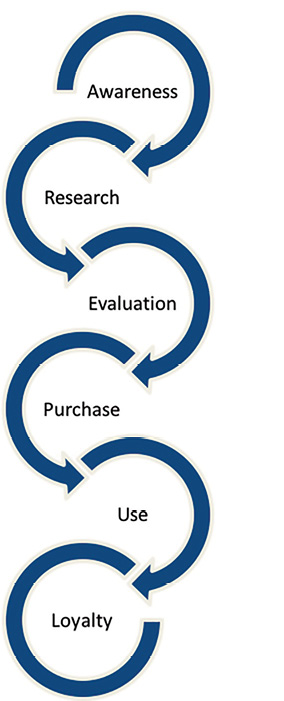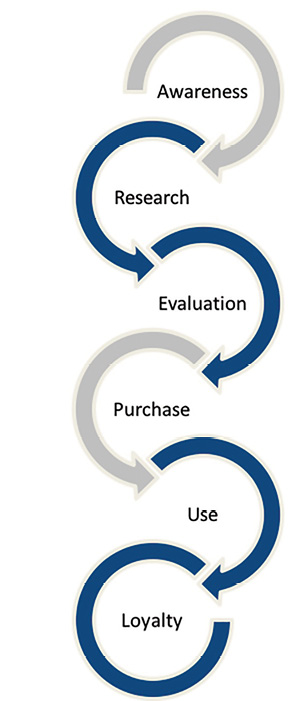By Andrea L. Ames | Fellow
Why an article about marketing in a magazine for technical communicators? Because we, my friends, are the future of marketing. And now you’re thinking, “Whaaaat?” Yes, it’s a controversial idea, but I believe it’s true. Here’s why.
The Marketing Story
Over the past decade or so, as businesses have become increasingly digital, the sales and marketing approaches of those businesses have been forced to change and evolve. Marketing programs have become digital. Internet, or online, marketing has seen double-digit growth since 2012, according to the CMO Survey (2017), with Forbes saying there’s no sign of that growth slowing through 2021 (VanBoskirk 2017).
As our companies transact businesses through more digital means, we are more and better able to track our customers through nearly every interaction with us. This journey, or experience, has become a holy grail of digital business. You’ve likely seen a representation of this journey, for example (see Figure 1).
The Content Story
Over that same 10 years, as our businesses become more digital, we have seen first-hand the important role that content plays in that evolution. Content has become critical to creating a conversation with customers and potential customers. And content carries more and more of the relationship with our customers during their entire experience with us.
Content + marketing = content marketing

a strategic marketing approach focused on creating and distributing valuable, relevant, and consistent content to attract and retain a clearly defined audience—and, ultimately, to drive profitable customer action. (Source: “What Is Content Marketing?”)
Books, tools, and events around content marketing illustrate its quickly growing popularity.
What has any of this got to do with technical content? Or me?
If we take a closer look at the journey (see the dark blue phases depicted in Figure 2), we can see how technical content fits it. The value of technical content at the end of the journey—the “use” and “loyalty” phases—is easy to see. “Use,” in particular, is our sweet spot, and if we and the design team do our jobs well, “use” can swiftly convert to “loyalty” and perhaps even transform our customers into raving fans.
Marketing often has grand plans for creating those raving fans—references, advocates, call them what you like—and they sometimes treat retweets and other social trivialities like a sign of advocacy. I see a gap in the marketing plan—a gap between “purchase” and “loyalty” that comes from successful product use. And that, technical communicators, is where we can shine!

Great technical content that describes how the product will address the customer’s needs (benefits) and that can show the customer how to achieve those benefits quickly and easily is pure gold in marketing terms.
Your next actions
All of this assumes that your content is valuable. What does that mean? It must be:
- Relevant to a real customer problem or need
- Aligned with your product strategy and marketing messaging
Sadly, this is not enough. To close the loop between marketing, content, content marketing, and technical content, you must have a relationship with your marketers. Understand the marketing and marketing strategy. Co-develop an end-to-end content strategy. And create your content with their input as an internal customer.
If you can do this, you will elevate your content from telling customers what your product does and how to use it to telling them how it will solve their business needs and why they should buy it. You might even get some credit from driving revenue, acquiring customers, retaining customers, or creating a raving fan or two!
And as marketers realize how valuable post-sales product content can be in their content marketing efforts, your content will become the future of marketing in your company.
References
The CMO Survey (2017). Accessed 1 August 2017. https://cmosurvey.org/results/august-2017/.
VanBoskirk, Shar. 2017. “US Digital Marketing Spend Will Near $120 Billion By 2021.” Forbes, Jan. 26, 2017. https://www.forbes.com/sites/forrester/2017/01/26/us-digital-marketing-spend-will-near-120-billion-by-2021/#4c513e75278b.
“What Is Content Marketing?” 2012. Content Marketing Institute. Accessed 1 August 2017. http://contentmarketinginstitute.com/what-is-content-marketing/.


